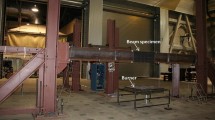Abstract
Critical temperature is defined as the temperature at which failure is expected to occur in a structural steel member given a uniform temperature distribution and load level. Determination of the critical temperature is a simple but efficient way for structural fire design. This paper proposed a new model which incorporated the buckling, load levels and non-dimensional slenderness to calculate the critical temperature of steel member under fire based on the simple calculation models in Eurocode 3. To advance the application of this new model, design charts for determining the critical temperatures were developed. The design charts showed that the critical temperature decreases with increasing load level, and increases as the buckling curve varies from “a0” to “d”. It is also recommended to use higher grade steel in both normal and fire situations. The accuracy of this model was ascertained by comparing with the test results in available literature. The new model gave an average prediction-to-test ratio of 0.980 with a standard deviation of 0.077, indicating conservative and less scattered predictions. The percentage of over-prediction (i.e., prediction-to-test ratio >1.0) was less than 5.8% when the nominal yield strength of steel rather than its test strength was used for predictions. In general, reasonable agreements were obtained between the test results and the predictions.









Similar content being viewed by others
References
European Committee for Standardization (2005) Eurocode 3: design of steel structures—part 1–2: general rules-structural fire design, EN 1993-1-2
Skowronski W (1990) Load capacity and deflection of fire-resistant steel beams. Fire Technol 26(4):310–328. doi:10.1007/BF01293076
Stanzak WW, Harmathy TZ (1968) Effect of deck on failure temperature of steel beams. Fire Technol 4(4):265–270. doi:10.1007/BF02588637
Neves IC (1995) The critical temperature of steel columns with restrained thermal elongation. Fire Saf J 24:211–227
Rodrigues JPC, Neves IC, Valente JC (2000) Experimental research on the critical temperature of compressed steel elements with restrained thermal elongation. Fire Saf J 35:77–98
Mesquita LMR, Piloto PAG, Vaz MAP, Vila Real PMM (2005) Experimental and numerical research on the critical temperature of laterally unrestrained steel I beams. J Constr Steel Res 61:1435–1446
Wang PJ, Wang YC, Li GQ (2010) A new design method for calculating critical temperatures of restrained steel column in fire. Fire Saf J 45:349–360
Tan YH, Li QM, Xi F (2014) Dynamic response and critical temperature of a steel beam subjected to fire and subsequent impulsive loading. Comput Struct 135:100–108
Shepherd PG, Burgess IW (2011) On the buckling of axially restrained steel columns in fire. Eng Struct 33:2832–2838
Wang YC, Moore DB (1994) Effect of thermal restraint on column behavior in a frame. In: Kashiwagi T (ed) Proceedings of the 4th international symposium on fire safety science, pp 1055–1066
Franssen JM (2000) Failure temperature of a system comprising a restrained column submitted to fire. Fire Saf J 34:191–207
European Committee for Standardization (2002) Eurocode—basis of structural design, EN 1990
European Committee for Standardization (2002) Eurocode 1: actions on structures—part 1-1: general actions-densities, self-weight, imposed loads for buildings, EN 1991-1-1
European Committee for Standardization (2002) Eurocode 1: actions on structures—part 1-2: general actions-actions on structures exposed to fire, EN 1991-1-2
European Committee for Standardization (2005) Eurocode 3: design of steel structures—part 1-1: general rules and rules for buildings, EN 1993-1-1
Wainman DE, Kirby BR (1988) Compendium of UK standard fire test data: unprotected structural steel—1. British Steel Corporation, Swinden Laboratories, Rotherham
Franssen JM, Schleich JB, Cajot LG, Azpiazu W (1996) A simple model for the fire resistance of axially loaded members—comparison with experimental results. J Constr Steel Res 37(3):175–204
Author information
Authors and Affiliations
Corresponding author
Rights and permissions
About this article
Cite this article
Xiong, MX., Huang, ZY. & Liew, J.Y.R. Modified Critical Temperatures for Steel Design Based on Simple Calculation Models in Eurocode 3. Fire Technol 53, 227–248 (2017). https://doi.org/10.1007/s10694-015-0522-x
Received:
Accepted:
Published:
Issue Date:
DOI: https://doi.org/10.1007/s10694-015-0522-x




